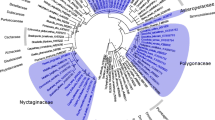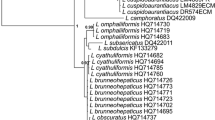Abstract.
A molecular survey of basidiomycete ectomycorrhizal fungi colonising root tips at a site in Eucalyptus marginata (jarrah) forest revealed the presence of many fungal species which could not be identified from a database of ITS-PCR-RFLP profiles from morphologically identified species. Three of these unidentified taxa were among the six most frequently encountered profiles. Phylogenetic analyses of ITS and nuclear LSU sequences revealed a close relationship among the three fungi and that they belong to the family Sebacinaceae (sensu Weiß and Oberwinkler 2001). The possibility that DNA of non-ectomycorrhizal rhizosphere or endophytic fungi had been amplified selectively by the basidiomycete-specific primers was tested by amplification with fungal-specific primers. A single PCR fragment was amplified in all but two of the 24 samples tested and digestion with two restriction enzymes produced RFLP profiles which matched those from the Sebacinoid sequence. We conclude, therefore, that at least three species of Sebacinaceae are common ectomycorrhizal associates of E. marginata.
Similar content being viewed by others
Author information
Authors and Affiliations
Additional information
Electronic Publication
Rights and permissions
About this article
Cite this article
Glen, .M., Tommerup, .I., Bougher, .N. et al. Are Sebacinaceae common and widespread ectomycorrhizal associates of Eucalyptus species in Australian forests?. Mycorrhiza 12, 243–247 (2002). https://doi.org/10.1007/s00572-002-0180-y
Received:
Accepted:
Issue Date:
DOI: https://doi.org/10.1007/s00572-002-0180-y




